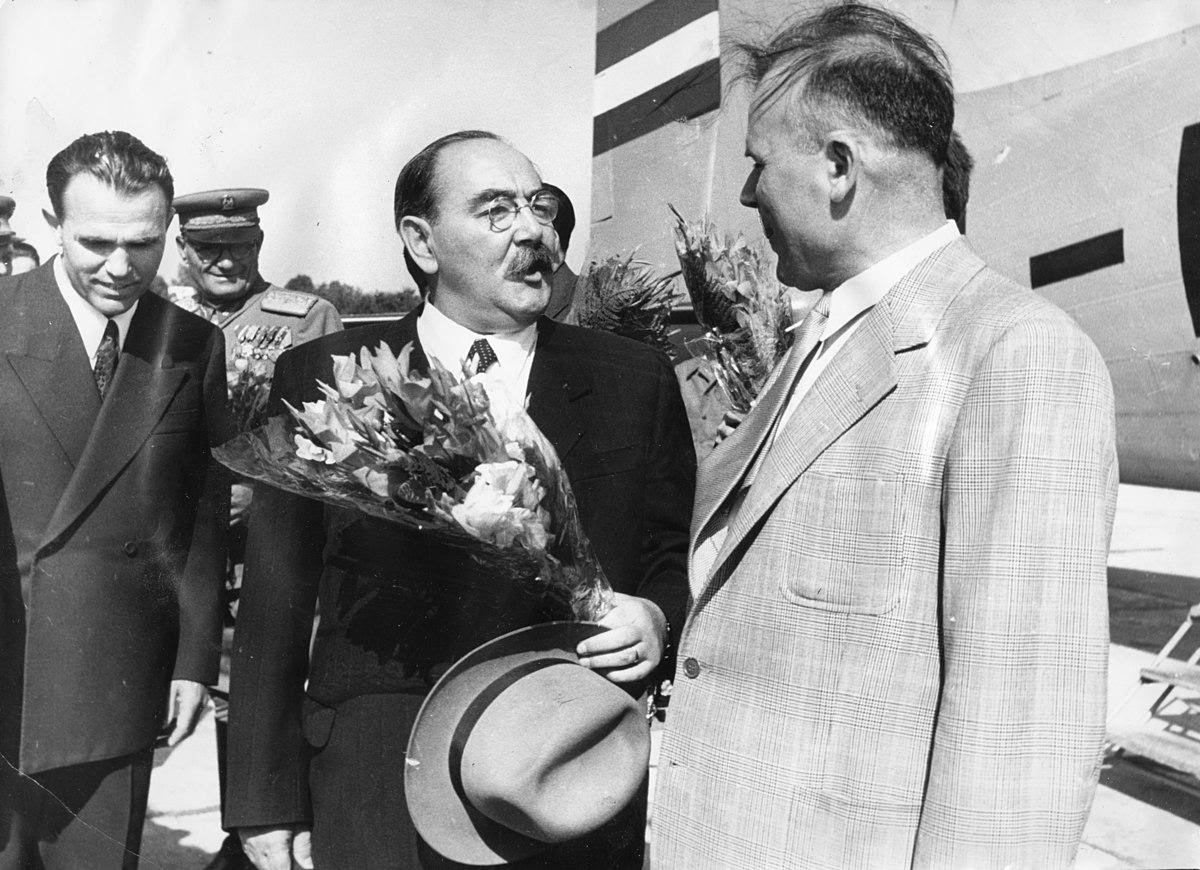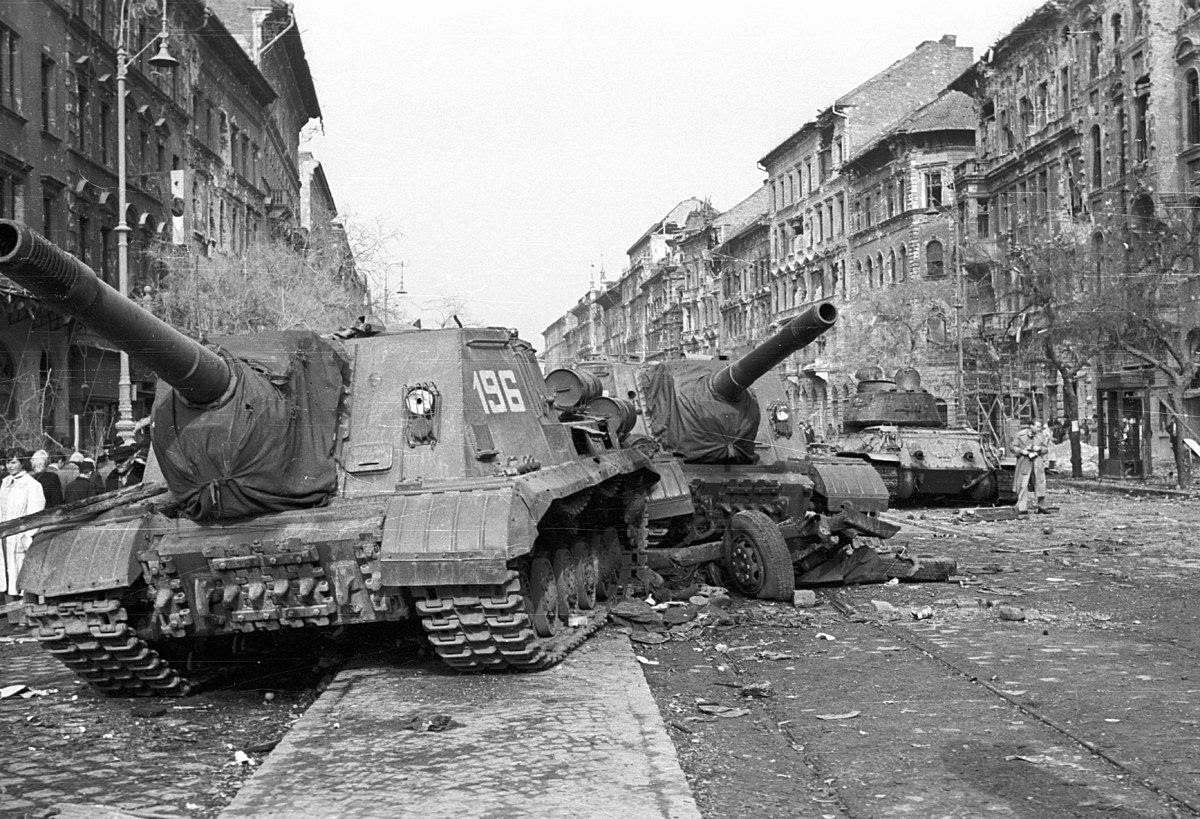

Table of Contents
As World War II came to an end, both Europe and the world slowly started to divide between two major powers – the US in the west and the USSR in the east. Though in the immediate post-war years these two blocs tried to at least present themselves as friends, by the late 1940s it was clear that the two ideological camps entered a confrontation that was quickly dubbed the Cold War. It was painted as an ongoing struggle for world supremacy of two ideas – capitalism in the west and communism in the east.
Hungary amidst the Cold War
In that divided world, Hungary fell into the Soviet camp, as it was liberated from fascists rule by the Red Army. A communist satellite government was quickly erected under the leadership of Mátyás Rákosi. The Hungarian leadership followed the examples of the Soviet Stalinist path, both in internal and external politics. In terms of foreign politics, it meant unwavering support of the USSR. An example of this would be siding with the Soviet Union after the Tito-Stalin split of 1948, cutting off economic ties, adhering to a public attack on the Yugoslav regime, and much more. In terms of domestic policies, the Hungarian government began to build a communist society by the nationalization of private property, collectivization, and forced industrialization. This was followed by various forms of political oppression, reeducation as well as state brutality as many have been imprisoned, relocations, and in some cases even executions. However, due to war destruction, war reparations imposed on Hungary for its participation in the war on the German side, and erroneous leadership, the Hungarian economy was in general decline.
Furthermore, Soviet troops were stationed in Hungary, both as a part of the post-war punishment but even more as backing for the new regime. Thus, by the early 1950s, many Hungarians began feeling like they were under some kind of occupation, led by domestic collaborators. That being said, it should be noted that despite that, there were plenty of Hungarian communists supporting at least a new ideology if not the ruling government. Then in March 1953, Stalin died and after an internal power struggle, Nikita Khrushchev came to power. Unlike his predecessor, Khrushchev is championing a more liberal approach towards communism. This echoed across the eastern bloc, as many hoped that this would lead to some kind of relaxation of both internal and Soviet pressure. Indeed, some strides were made as by mid-1953, Rákosi was substituted in the office of Hungarian Prime Minister by Imre Nagy, a prominent reformer and leader of the liberal branch of the Hungarian communists. Regardless, Rákosi remained General Secretary of the Party, enabling him to keep ballast for Nagy and his reforms.

Nagy after his trip to Moscow in 1953. Wikimedia Commons
Over the next couple of years, USSR continued its strides towards so-called destalinization which culminated in Khrushchev’s denunciation of Stalin and his politics. He had done so in February 1956, during the 20th Congress of the Communist Party of the Soviet Union, signaling the end of Stalinist oppression to some. Despite the steps in that direction, in 1955 USSR formed the Warsaw Pact, a communist mirror of NATO which the US formed in 1949. Through it, all of the European communist nations were tethered to the USSR, except Yugoslavia which remained outside of the direct Soviet control. At the roughly same time, Nagy fell out of Soviet favor with his approach to communist reforms in his so-called “New Course”. Regardless, the US and its western allies saw Khrushchev’s reforms as a possible weakness to exploit in an attempt to diminish Soviet influence and grip over the East European nations.
With that in mind, the United States tried to “warm” their relations with the communist bloc, including Hungary, subtly instigating them to either overthrow communism or at least attempt to find a milder form of it, shrugging off the Soviet influence. The capitalist bloc tried to achieve this in various forms, from economic pressure and relief, across various covert missions, propaganda, and radio programs (Voice of America or BBC radio for example), to straight up political contact. Among the targeted nations was Hungary, whose worsening economic situation created a fertile ground for all of the activities. By early 1956, the Hungarian government opened talks with the US, looking for financial aid and import of various goods. In return, they were prepared to ease travel restriction, even flirting with the idea of lessening the state oppression of the ruling regime.
Rebellion and the Soviet intervention
However, it is important to note that this Hungarian coquetry wasn’t done by Nagy who was deposed in April of 1955. He lost all his positions both in the government and in the party. The instability of the Hungarian government was only to increase after Khrushchev denunciated Stalin. The dissatisfaction of the population grew, with it Rákosi began to lose ground. Finally, the Soviets deposed him in July of 1956. This was caused by his failures as a Hungarian leader but also because he was a prominent leftover of the former Stalinist regime. At roughly the same time, social unrest and protests erupted in Poland. Though the Polish demonstrations were broken up, it eventually led to a liberalization of Poland in October of 1956 under a reformist communist Władysław Gomułka. This became a beacon of hope for Hungarians who hoped they could achieve something similar. When Hungarian students saw Gomułka’s triumph, they went out on the streets of Budapest, issuing their demands for liberalization, democratization, reforms, and evacuation of Soviet troops from Hungary. These changes were to be made under the leadership of Nagy, who the students wanted to see reinstated.
Rákosi’s heirs called for Soviet intervention, as the Red Army deployed its troops across Budapest. Initially, the Soviets tried to refrain from violence, simply trying to secure the Hungarian government. Simultaneously, Nagy was reinstated in the party as many saw his reformist policies as a possible solution for a peaceful quelling of the Hungarian revolt. However, violence erupted across Hungary, as the rebels clashed both with the Hungarian military and police, as well as the deployed Soviet troops. By the 28th of October, Nagy secured a more stable position in the government, while the remnants of the Rákosi’s regime fled the country. With that, Nagy was able to secure a truce as well as the withdrawal of Soviet troops. The USSR was willing to comply, as they believed Nagy would reinstate peace and more importantly communist rule. However, carried by the demands of the protestors, Nagy declared he planned to return to the multi-party system. It wasn’t supposed to be a full democracy, but a limited one based on the socialist parties. Furthermore, on November 1st he declared withdrawal from the Warsaw Pact, prompted by the Soviet army brief reentry into Hungary, pleading for an internationally accepted and confirmed neutrality, as Austria achieved in late 1955.

Two Soviet ISU-152 self-propelled guns in Budapest with an abandoned T-34/85 tank in the background Wikimedia Commons
This was a step too far for the Soviets, was realized that Hungary was on the brink of both exiting the Soviet sphere and deposing communism. Thus, between 1st and 3rd November, the Soviet representatives visited several eastern nations preparing their intervention which began in the dawn of 4th of November. The core of rebellion was quickly quelled, while sporadic and isolated fighting continued until 11th November. Nagy tried to flee, seeking sanctuary in the Yugoslav embassy, while János Kádár was installed by the Soviets as a new Hungarian leader. He restored a Soviet-like system, but closer to the ideals of Khrushchev than to Stalin. It proved that all the fighting and thousands of dead and wounded were in vain.
Echoes of the Hungarian uprising
Nonetheless, the Hungarian Revolution of 1956 rippled across the globe, representing a massive failure for the Soviets. It demonstrated the extent of the oppressiveness of the communist regimes, headed by the Soviets. Revolution also showed that despite the communist brotherly rhetoric from Moscow, behind it all lied the very same imperialist and power-hungry politics. Furthermore, it showcased the economic weakness of the eastern bloc, as it was in fact one of the reasons behind the Hungarian uprising. In the end, the Hungarian revolution displayed that the USSR had to use force and threats to keep its allies in line. Many western leftists were left disenchanted with such an image of the Soviets.

A cartoon from Daily Mirror depicting Khrushchev (pointing at Lenin’s picture) with caption ‘Bah! Counter-revolutionaries!’ Spartacus Educational
Such conclusions are easy to make, as the Soviets proved them by their direct actions. However, the revolt of 1956 was simultaneously a failure of the US and its western allies. After years of instigating discontent, rebellion, and heating hope for assistance against the Soviet oppression, the capitalist bloc remained staggeringly inactive when it came to the Hungarian Revolution. Apart from lukewarm condemnation and criticism of Soviet intervention, the United States did nothing to help the so-called Freedom Fighters and rebels. Such inactivity, which is in fact why the American failure is less noticeable, came from the fact that the US realized that any direct action taken in Hungary could potentially lead to a “hot” war with the USSR, which was too pricey for them. Even worse for the Americans was the fact that literally at the same time England, France, and Israel military intervened in Egypt during the so-called Suez Crisis. In such a position, the US was unable to fully condemn the Soviets while approving the intervention of its allies in Egypt. Because of that, many eastern dissidents became disillusioned in American politics and calls for freedom and struggle against communism.
However, the Hungarian Revolt also proved to be a letdown for the neutral path in world politics of the time. On one hand, in early 1957 the UN formed a committee to investigate the events of the uprising. By the summer of that year, this committee presented its findings in a document that concluded that the Soviet intervention as well as the new Kádár administration violated human rights in Hungary. Yet once again apart from public condemnation in the UN General Assembly resolution, no other concrete action was taken. Apart from the UN, the Yugoslav reaction could also be seen as a failure of the neutral path at that time Yugoslavia began its affirmation as a champion of neutrality that would eventually lead to the formation of the Non-aligned Movement in Belgrade.
Initially, Tito was wary of Nagy but possibly hoped Hungary and Poland would end up closer to Yugoslavia than to USSR. Nonetheless, with open revolt and the possibility of communist fall from reign, Yugoslav leadership became pro-interventionist, giving their full support to the Soviets’ action. Furthermore, it was Tito who advocated for the installation of Kádár, hoping it would allow him more sway over the future of Hungary. His position was further weakened after Nagy found refuge in the Yugoslav embassy. He was caught between the Soviets, with whom he tried to thaw the relations and his public face of neutrality if he left Nagy to his fate. Here, once again neutrality showed its weakness, as on November 11th Tito at the same time deplored the Soviet invasion, yet classified it as a lesser of two evils. It is also significant to note that at the time Yugoslav leadership expressed support for Kádár’s government. The epilogue of the story was that by the end of November, the Yugoslav government managed to secure a written promise of safe passage for Nagy from Kádár, yet he was imprisoned almost immediately after leaving the embassy. Nagy was taken to Romania, secretly tried, and executed. This exemplified a bankruptcy of neutrality, while also showing that the written word means nothing even if it is between two communist nations.
In the end, the Hungarian Revolution of 1956 confirmed that despite the rhetoric’s on all sides, the Cold War division as it was set became an irreversible reality. Ideology, morality, and friendship had no place in this world, as every nation only looked at their own needs and agendas. With that, the Hungarian uprising was in fact a fiasco for both Hungary and the entire Cold War world.
Further reading
-
Borhi, L. (1999), Rollback, Liberation, Containment, or Inaction? U.S. Policy and Eastern Europe in the 1950s., Journal of Cold War Studies, 1(3) 1999, pp. 67–110.
-
Christopher Adam [et al.], The 1956 Hungarian Revolution: Hungarian and Canadian perspectives, University of Ottawa Press, 2010.
-
Csaba Békés [et al.], The 1956 Hungarian revolution: a history in documents, Central European University Press, 2002.
-
David M. Watry, Diplomacy at the brink: Eisenhower, Churchill, and Eden in the Cold War, Louisiana State University Press, 2014.
-
E. A. Schmidl and L. Ritter, The Hungarian Revolution 1956, Osprey Publishing, 2006.
-
Johanna Granville, Hungary, 1956: The Yugoslav Connection, Europe-Asia Studies, Vol. 50, No. 3 (May, 1998), pp. 493-517.
-
Paul Lendvai, One day that shook the communist world: the 1956 Hungarian uprising and its legacy, Princeton University Press, 2008.
-
Ronald D. Landa, The 1956 Hungarian Revolution: A Fresh Look at the U.S. Response (Draft), Historical Office of the Office of the Secretary of Defense, 2012.
-
United Nations committee, Report of the Special Committee on the Problem of Hungary, United Nations 1957.
-
Zoltán Ripp, Hungary’s Part in the Soviet-Yugoslav Conflict, 1956-58, Contemporary European History, Vol. 7, No. 2 (Jul., 1998), pp. 197-225.
